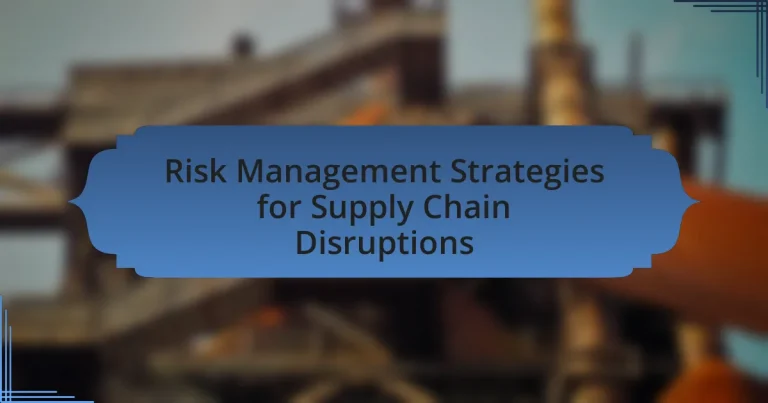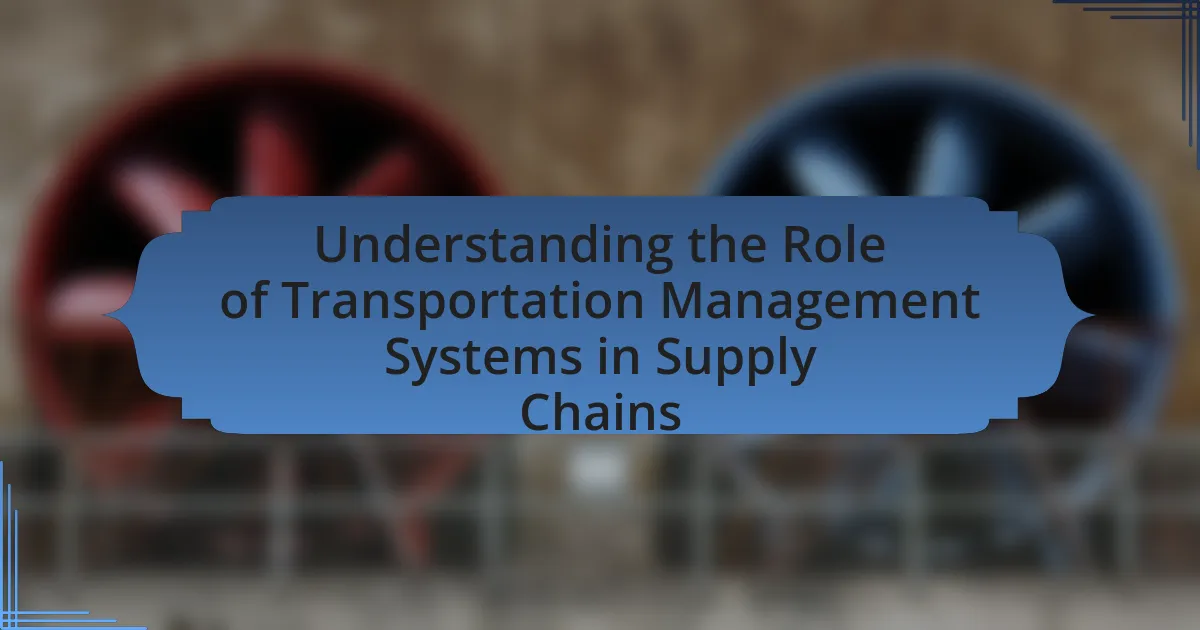Risk management strategies for supply chain disruptions are essential for maintaining operational continuity and resilience in the face of potential threats. Key strategies include diversification of suppliers, effective inventory management, and the use of technology for real-time monitoring. These approaches help mitigate various risks such as operational, financial, reputational, and compliance risks, ultimately enhancing supply chain robustness. The article also highlights the importance of risk assessment, communication, and contingency planning, along with the role of advanced technologies in improving risk management outcomes. By implementing these strategies, organizations can better prepare for and respond to unforeseen disruptions, ensuring sustained performance and competitiveness.
What are Risk Management Strategies for Supply Chain Disruptions?
Risk management strategies for supply chain disruptions include diversification of suppliers, inventory management, and the implementation of technology for real-time monitoring. Diversification of suppliers reduces dependency on a single source, thereby mitigating risks associated with supplier failures. Effective inventory management, such as maintaining safety stock, ensures that companies can continue operations during disruptions. Additionally, utilizing technology like supply chain management software enables organizations to track and respond to disruptions promptly, enhancing overall resilience. These strategies are supported by industry studies indicating that companies employing such measures experience fewer operational interruptions and improved recovery times during crises.
How do these strategies help mitigate risks in supply chains?
Risk management strategies help mitigate risks in supply chains by identifying potential disruptions and implementing proactive measures to address them. These strategies, such as diversification of suppliers, inventory management, and real-time monitoring, reduce vulnerability to single points of failure. For instance, a study by the Supply Chain Management Review found that companies employing multiple sourcing strategies experienced 30% fewer disruptions compared to those relying on a single supplier. This evidence demonstrates that effective risk management strategies enhance resilience and ensure continuity in supply chain operations.
What types of risks do these strategies address?
These strategies address various types of risks associated with supply chain disruptions, including operational risks, financial risks, reputational risks, and compliance risks. Operational risks involve interruptions in the supply chain due to factors like natural disasters, supplier failures, or logistical challenges. Financial risks arise from increased costs or loss of revenue due to disruptions. Reputational risks occur when supply chain issues affect customer trust and brand image. Compliance risks relate to failing to meet regulatory requirements during disruptions. Each of these risks can significantly impact a company’s performance and sustainability, highlighting the importance of effective risk management strategies.
How do these strategies enhance supply chain resilience?
Risk management strategies enhance supply chain resilience by identifying potential disruptions and implementing proactive measures to mitigate their impact. These strategies, such as diversification of suppliers, inventory management, and real-time data analytics, allow organizations to adapt quickly to changes and maintain operational continuity. For instance, a study by the MIT Center for Transportation and Logistics found that companies employing diversified sourcing strategies experienced 30% less disruption during crises compared to those relying on single-source suppliers. This evidence demonstrates that effective risk management not only prepares supply chains for unforeseen events but also strengthens their overall robustness and adaptability.
Why is it important to implement risk management strategies?
Implementing risk management strategies is crucial for minimizing potential disruptions in supply chains. These strategies help organizations identify, assess, and prioritize risks, enabling them to develop effective responses that mitigate negative impacts. For instance, a study by the Supply Chain Management Review found that companies with robust risk management frameworks experienced 30% fewer disruptions compared to those without such strategies. This evidence underscores the importance of proactive risk management in maintaining operational continuity and enhancing resilience against unforeseen challenges.
What are the potential consequences of ignoring risk management?
Ignoring risk management can lead to significant financial losses and operational disruptions. Organizations that neglect risk management may face unexpected supply chain interruptions, resulting in increased costs and reduced profitability. For instance, a study by the Business Continuity Institute found that 75% of organizations experienced at least one disruption in the past year, highlighting the financial impact of unaddressed risks. Additionally, failure to manage risks can damage a company’s reputation, leading to loss of customer trust and market share. In extreme cases, ignoring risk management can result in business failure, as evidenced by the collapse of companies that could not adapt to unforeseen challenges.
How can effective risk management improve operational efficiency?
Effective risk management enhances operational efficiency by identifying potential disruptions and implementing strategies to mitigate their impact. By proactively assessing risks, organizations can streamline processes, allocate resources more effectively, and reduce downtime. For instance, a study by the Supply Chain Management Review found that companies with robust risk management frameworks experienced 30% fewer supply chain disruptions, leading to improved productivity and cost savings. This demonstrates that effective risk management not only safeguards operations but also fosters a more resilient and efficient supply chain.
What are the key components of effective risk management strategies?
The key components of effective risk management strategies include risk identification, risk assessment, risk mitigation, and continuous monitoring. Risk identification involves recognizing potential risks that could impact supply chain operations, such as supplier failures or natural disasters. Risk assessment evaluates the likelihood and impact of these risks, allowing organizations to prioritize them based on severity. Risk mitigation encompasses developing strategies to minimize the impact of identified risks, such as diversifying suppliers or increasing inventory levels. Continuous monitoring ensures that risk management strategies remain effective and relevant by regularly reviewing and updating risk assessments and mitigation plans. These components collectively enhance an organization’s ability to navigate supply chain disruptions effectively.
How do risk assessment and analysis contribute to strategy development?
Risk assessment and analysis are critical components of strategy development as they identify potential threats and vulnerabilities within a supply chain. By systematically evaluating risks, organizations can prioritize their responses and allocate resources effectively, ensuring that strategic plans are resilient to disruptions. For instance, a study by the Supply Chain Risk Management Consortium found that companies employing robust risk assessment frameworks experienced 30% fewer supply chain disruptions compared to those that did not. This evidence underscores the importance of integrating risk analysis into strategic planning to enhance operational stability and competitive advantage.
What tools are used for risk assessment in supply chains?
Risk assessment in supply chains utilizes various tools, including risk matrices, simulation models, and software solutions like SAP Risk Management and RiskWatch. Risk matrices help visualize and prioritize risks based on their likelihood and impact, while simulation models, such as Monte Carlo simulations, assess potential disruptions and their effects on supply chain performance. Software solutions provide comprehensive data analysis and reporting capabilities, enabling organizations to identify vulnerabilities and develop mitigation strategies effectively. These tools are essential for enhancing resilience and ensuring continuity in supply chain operations.
How can data analytics improve risk analysis outcomes?
Data analytics can significantly improve risk analysis outcomes by enabling organizations to identify, assess, and mitigate risks more effectively. By leveraging large datasets, analytics tools can uncover patterns and trends that traditional methods may overlook, allowing for more accurate predictions of potential disruptions. For instance, a study by McKinsey & Company found that companies using advanced analytics in their risk management processes experienced a 20-30% reduction in risk-related costs. This demonstrates that data-driven insights lead to better-informed decision-making, ultimately enhancing the resilience of supply chains against disruptions.
What role does communication play in risk management strategies?
Communication is essential in risk management strategies as it facilitates the identification, assessment, and mitigation of risks. Effective communication ensures that all stakeholders are informed about potential risks and the strategies in place to address them, which enhances collaboration and decision-making. For instance, a study by the Project Management Institute found that organizations with strong communication practices are 50% more likely to complete projects on time and within budget, highlighting the importance of clear information flow in managing risks effectively.
How can effective communication reduce the impact of disruptions?
Effective communication can significantly reduce the impact of disruptions by ensuring timely information sharing and coordination among stakeholders. When all parties involved in a supply chain are informed about potential disruptions, such as delays or shortages, they can make informed decisions quickly, minimizing downtime and resource wastage. For instance, a study by the Council of Supply Chain Management Professionals found that companies with robust communication strategies experienced 25% fewer disruptions compared to those with poor communication practices. This highlights that effective communication not only facilitates immediate responses but also fosters collaboration, enabling stakeholders to develop contingency plans and adapt to changing circumstances efficiently.
What are best practices for stakeholder engagement during disruptions?
Best practices for stakeholder engagement during disruptions include maintaining transparent communication, actively involving stakeholders in decision-making, and providing timely updates on the situation. Transparent communication fosters trust and ensures that stakeholders are informed about the nature of the disruption and its potential impacts. Actively involving stakeholders in decision-making allows for diverse perspectives and can lead to more effective solutions. Timely updates keep stakeholders engaged and prepared for any changes, which is crucial during uncertain times. These practices are supported by research indicating that effective communication and collaboration enhance resilience in supply chains during disruptions.
What are some common risk management strategies for supply chain disruptions?
Common risk management strategies for supply chain disruptions include diversification of suppliers, inventory management, and the implementation of technology for real-time monitoring. Diversification of suppliers reduces dependency on a single source, thereby mitigating risks associated with supplier failures. For instance, companies that source materials from multiple suppliers can better withstand disruptions caused by natural disasters or geopolitical issues. Effective inventory management, such as maintaining safety stock, ensures that companies can continue operations during supply chain interruptions. Additionally, utilizing technology like supply chain management software enables organizations to monitor their supply chains in real-time, allowing for quicker responses to potential disruptions. These strategies are supported by industry practices that emphasize resilience and adaptability in supply chain operations.
How can diversification of suppliers mitigate risks?
Diversification of suppliers mitigates risks by reducing dependency on a single source, which can lead to vulnerabilities in supply chains. When companies engage multiple suppliers, they can better manage disruptions caused by factors such as natural disasters, geopolitical issues, or supplier insolvency. For instance, a study by the Harvard Business Review found that companies with diversified supplier bases experienced 30% less disruption during crises compared to those relying on single suppliers. This strategy enhances resilience, allowing businesses to maintain operations and meet customer demands even when one supplier faces challenges.
What are the benefits of having multiple suppliers?
Having multiple suppliers enhances supply chain resilience by reducing dependency on a single source. This diversification mitigates risks associated with supply disruptions, such as natural disasters or supplier insolvency. For instance, a study by the Harvard Business Review found that companies with multiple suppliers experienced 30% fewer disruptions compared to those relying on a single supplier. Additionally, multiple suppliers foster competitive pricing and innovation, as businesses can leverage alternatives to negotiate better terms and access diverse product offerings.
How does supplier relationship management enhance risk mitigation?
Supplier relationship management enhances risk mitigation by fostering collaboration and transparency between organizations and their suppliers. This collaborative approach allows for the identification of potential risks early in the supply chain process, enabling proactive measures to be taken. For instance, companies that engage in regular communication and performance evaluations with suppliers can quickly address issues such as delays or quality concerns, thereby reducing the likelihood of disruptions. Research indicates that organizations with strong supplier relationships experience 50% fewer supply chain disruptions compared to those with weaker ties, highlighting the effectiveness of this strategy in mitigating risks.
What is the significance of contingency planning in risk management?
Contingency planning is significant in risk management as it prepares organizations to respond effectively to unforeseen events that could disrupt operations. This proactive approach enables businesses to identify potential risks, develop response strategies, and allocate resources efficiently, thereby minimizing the impact of disruptions. For instance, a study by the Business Continuity Institute found that organizations with robust contingency plans are 50% more likely to recover quickly from supply chain disruptions compared to those without such plans. This evidence underscores the critical role of contingency planning in enhancing resilience and ensuring continuity in supply chain operations.
How can businesses develop effective contingency plans?
Businesses can develop effective contingency plans by conducting thorough risk assessments to identify potential disruptions and their impacts. This process involves analyzing supply chain vulnerabilities, evaluating historical data on disruptions, and engaging stakeholders to gather insights. By prioritizing risks based on their likelihood and potential impact, businesses can create targeted strategies to mitigate these risks. For instance, a study by the Business Continuity Institute found that organizations with documented contingency plans are 50% more likely to recover quickly from disruptions. This evidence underscores the importance of proactive planning in enhancing resilience against supply chain disruptions.
What are the key elements of a successful contingency plan?
The key elements of a successful contingency plan include risk assessment, clear objectives, defined roles and responsibilities, communication strategies, resource allocation, and regular testing and updates. Risk assessment identifies potential disruptions and their impacts, while clear objectives outline what the plan aims to achieve during a crisis. Defined roles and responsibilities ensure that team members know their tasks, and communication strategies facilitate information flow among stakeholders. Resource allocation guarantees that necessary tools and personnel are available, and regular testing and updates keep the plan relevant and effective. These elements collectively enhance an organization’s resilience to supply chain disruptions.
What technology solutions can support risk management strategies?
Technology solutions that can support risk management strategies include advanced analytics, artificial intelligence, and blockchain technology. Advanced analytics enables organizations to identify potential risks by analyzing large datasets for patterns and trends, which can lead to proactive decision-making. Artificial intelligence enhances risk assessment by automating data analysis and providing predictive insights, allowing companies to anticipate disruptions before they occur. Blockchain technology improves transparency and traceability in supply chains, facilitating better risk management by ensuring that all parties have access to real-time information about the status of goods and potential risks. These technologies collectively enhance the ability to manage and mitigate risks effectively in supply chain operations.
How can supply chain visibility tools help in risk management?
Supply chain visibility tools enhance risk management by providing real-time data and insights into supply chain operations. These tools enable organizations to monitor inventory levels, track shipments, and identify potential disruptions proactively. For instance, a study by the Institute for Supply Management found that companies utilizing visibility tools experienced a 20% reduction in supply chain disruptions. By facilitating timely decision-making and improving communication among stakeholders, these tools help mitigate risks associated with delays, shortages, and other unforeseen events.
What role does automation play in enhancing supply chain resilience?
Automation significantly enhances supply chain resilience by increasing efficiency and reducing human error. Automated systems streamline processes such as inventory management, order fulfillment, and demand forecasting, allowing for quicker responses to disruptions. For instance, a study by McKinsey & Company found that companies implementing automation in their supply chains experienced a 20-30% improvement in operational efficiency. This efficiency enables businesses to adapt rapidly to changes in demand or supply, thereby maintaining continuity during crises. Additionally, automation facilitates real-time data analysis, which helps organizations identify potential risks and implement proactive measures, further strengthening their resilience against disruptions.
What are the best practices for implementing risk management strategies?
The best practices for implementing risk management strategies include conducting a thorough risk assessment, developing a risk management plan, and continuously monitoring and reviewing risks. Conducting a thorough risk assessment allows organizations to identify potential risks and their impacts, which is essential for effective planning. Developing a risk management plan involves outlining specific strategies to mitigate identified risks, ensuring that all stakeholders understand their roles and responsibilities. Continuous monitoring and reviewing of risks enable organizations to adapt to changing circumstances and improve their risk management processes over time. These practices are supported by the ISO 31000 standard, which emphasizes the importance of a structured approach to risk management in enhancing organizational resilience.
How can organizations foster a risk-aware culture?
Organizations can foster a risk-aware culture by integrating risk management into their core values and daily operations. This involves providing comprehensive training on risk identification and mitigation strategies, encouraging open communication about risks at all levels, and establishing clear policies that prioritize risk assessment in decision-making processes. Research indicates that organizations with a strong risk culture are 30% more likely to achieve their strategic objectives, as they proactively address potential disruptions rather than reactively managing crises.
What steps should be taken to regularly review and update risk strategies?
To regularly review and update risk strategies, organizations should implement a structured process that includes continuous monitoring, stakeholder engagement, and data analysis. Continuous monitoring involves tracking key performance indicators and risk metrics to identify emerging threats and opportunities. Stakeholder engagement ensures that insights from various departments, such as operations and finance, are incorporated into the risk strategy. Data analysis, including scenario planning and risk assessments, helps in evaluating the effectiveness of current strategies and making necessary adjustments. Regularly scheduled reviews, at least annually or bi-annually, are essential to ensure that the risk strategies remain relevant and effective in the face of changing supply chain dynamics.




